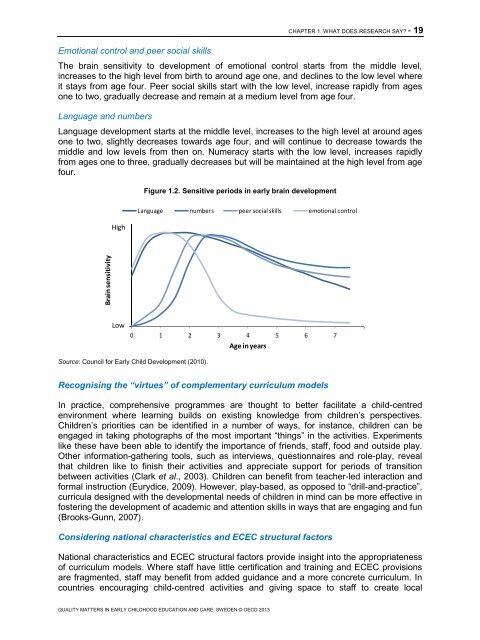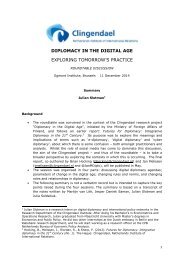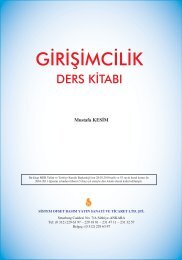SWEDEN%20policy%20profile%20-%20published%2005-02-2013
SWEDEN%20policy%20profile%20-%20published%2005-02-2013
SWEDEN%20policy%20profile%20-%20published%2005-02-2013
You also want an ePaper? Increase the reach of your titles
YUMPU automatically turns print PDFs into web optimized ePapers that Google loves.
QUALITY MATTERS IN EARLY CHILDHOOD EDUCATION AND CARE: SWEDEN © OECD <strong>2013</strong><br />
CHAPTER 1. WHAT DOES RESEARCH SAY? - 19<br />
Emotional control and peer social skills<br />
The brain sensitivity to development of emotional control starts from the middle level,<br />
increases to the high level from birth to around age one, and declines to the low level where<br />
it stays from age four. Peer social skills start with the low level, increase rapidly from ages<br />
one to two, gradually decrease and remain at a medium level from age four.<br />
Language and numbers<br />
Language development starts at the middle level, increases to the high level at around ages<br />
one to two, slightly decreases towards age four, and will continue to decrease towards the<br />
middle and low levels from then on. Numeracy starts with the low level, increases rapidly<br />
from ages one to three, gradually decreases but will be maintained at the high level from age<br />
four.<br />
Brain sensitivity<br />
High<br />
Figure 1.2. Sensitive periods in early brain development<br />
Language numbers peer social skills emotional control<br />
Low0<br />
0 1 2 3 4<br />
Age in years<br />
5 6 7<br />
Source: Council for Early Child Development (2010).<br />
Recognising the “virtues” of complementary curriculum models<br />
In practice, comprehensive programmes are thought to better facilitate a child-centred<br />
environment where learning builds on existing knowledge from children’s perspectives.<br />
Children’s priorities can be identified in a number of ways, for instance, children can be<br />
engaged in taking photographs of the most important “things” in the activities. Experiments<br />
like these have been able to identify the importance of friends, staff, food and outside play.<br />
Other information-gathering tools, such as interviews, questionnaires and role-play, reveal<br />
that children like to finish their activities and appreciate support for periods of transition<br />
between activities (Clark et al., 2003). Children can benefit from teacher-led interaction and<br />
formal instruction (Eurydice, 2009). However, play-based, as opposed to “drill-and-practice”,<br />
curricula designed with the developmental needs of children in mind can be more effective in<br />
fostering the development of academic and attention skills in ways that are engaging and fun<br />
(Brooks-Gunn, 2007).<br />
Considering national characteristics and ECEC structural factors<br />
National characteristics and ECEC structural factors provide insight into the appropriateness<br />
of curriculum models. Where staff have little certification and training and ECEC provisions<br />
are fragmented, staff may benefit from added guidance and a more concrete curriculum. In<br />
countries encouraging child-centred activities and giving space to staff to create local








